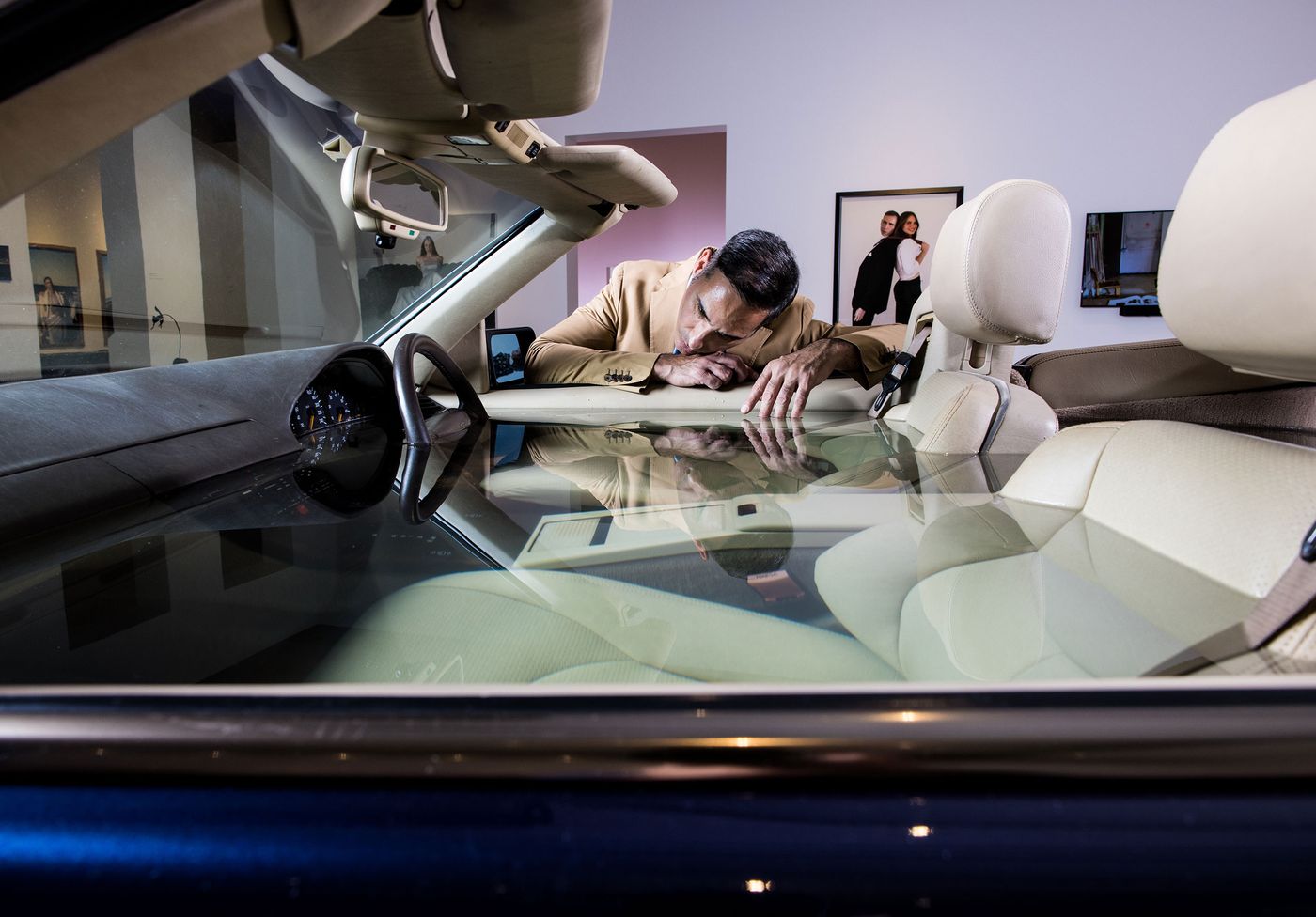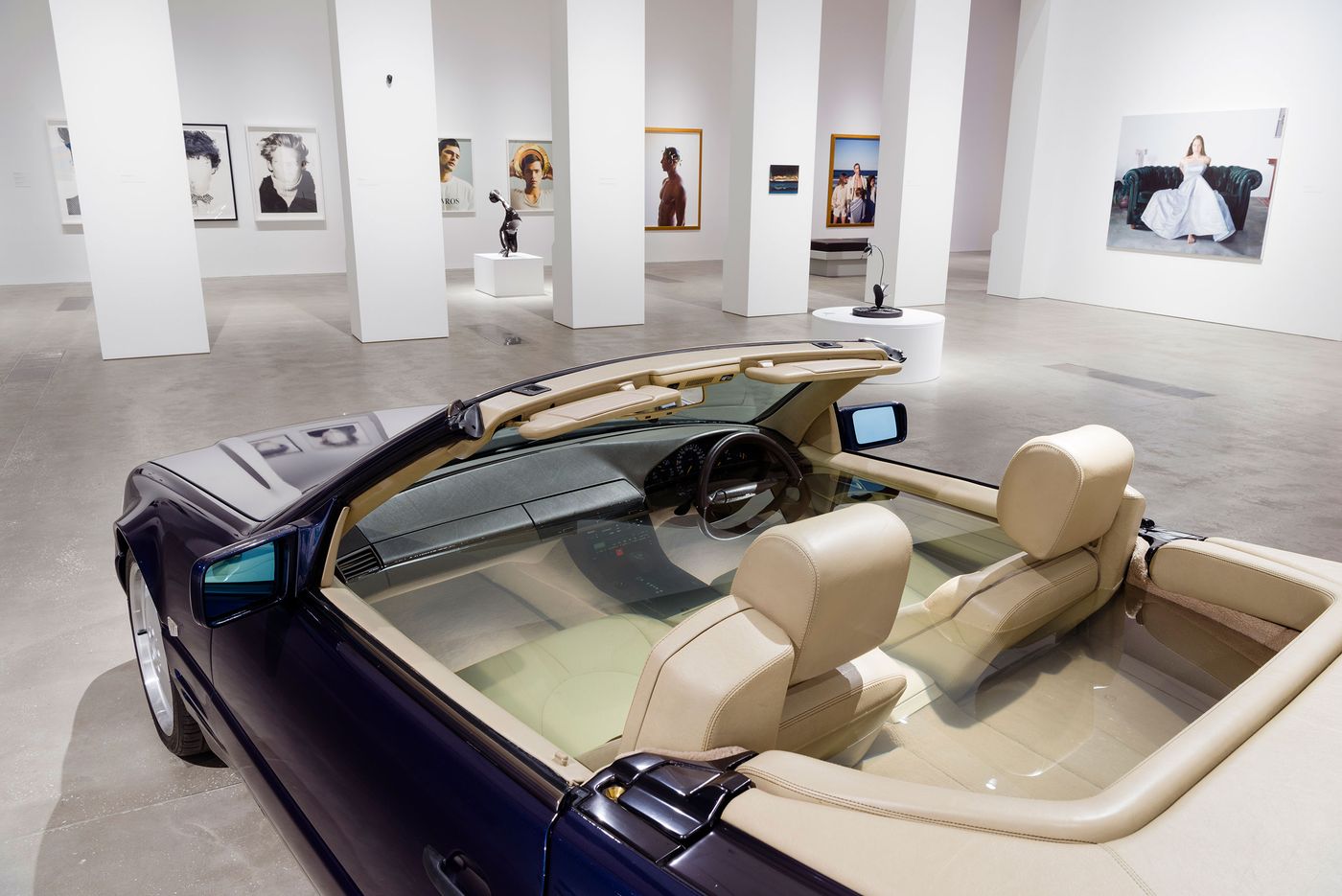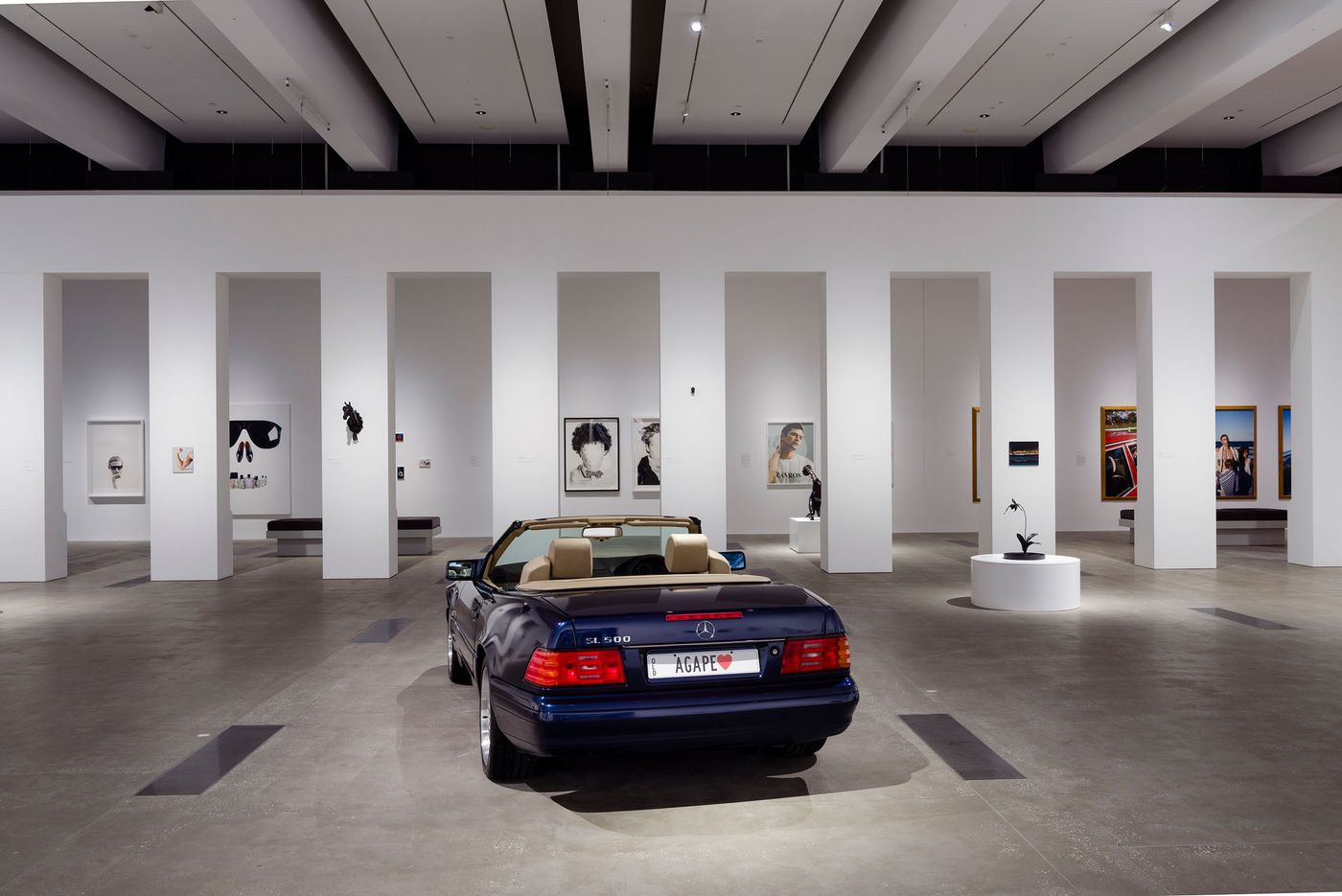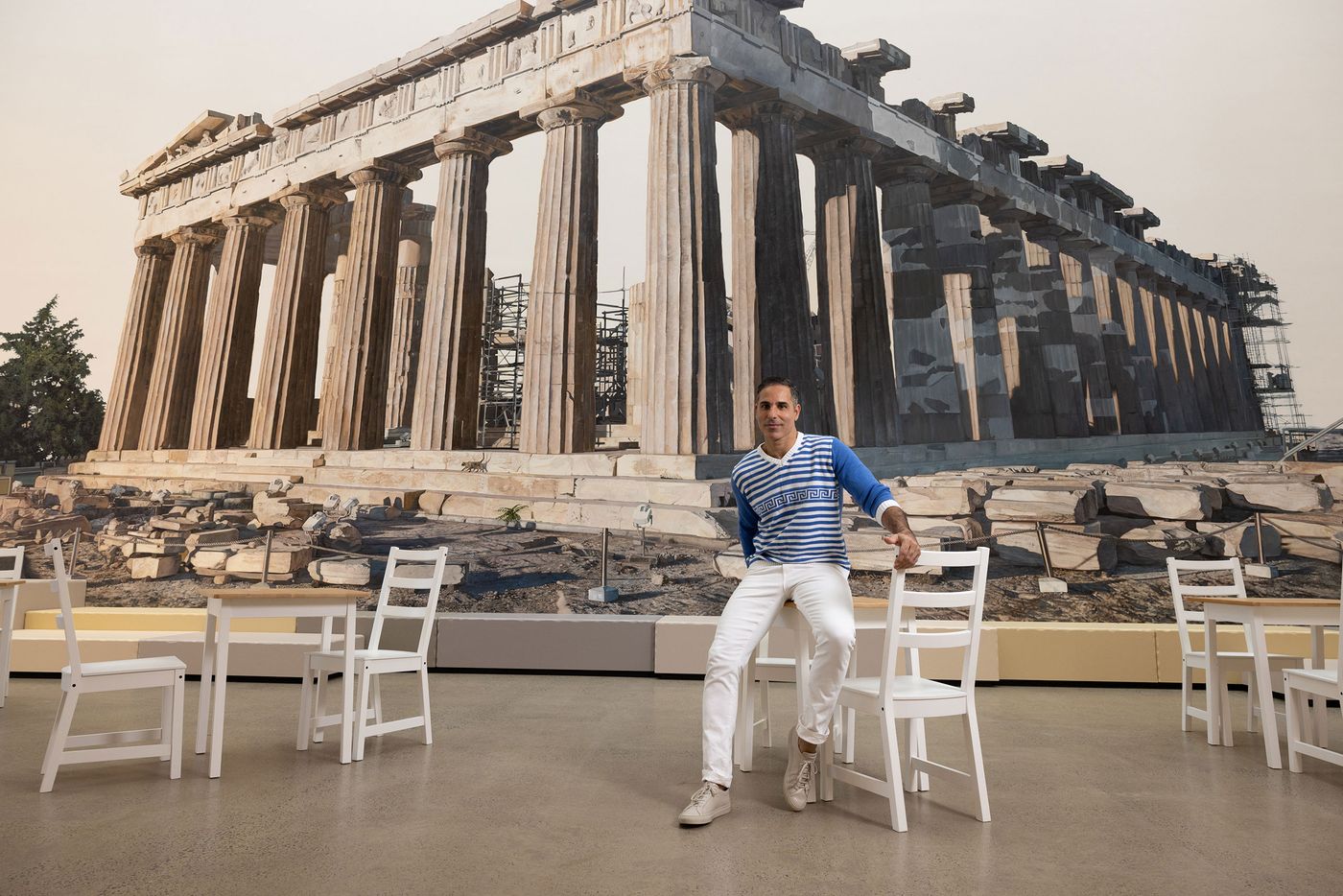
Life Imitates Art Imitates Life in Michael Zavros’ Retrospective Exhibition in Brisbane
Words by Eric David
Location
Brisbane, Australia
Life Imitates Art Imitates Life in Michael Zavros’ Retrospective Exhibition in Brisbane
Words by Eric David
Brisbane, Australia
Brisbane, Australia
Location
We have been fans of Brisbane-based, Greek-Australian artist Michael Zavros for more than a decade now, enthralled as much by the incredible detail of his hyper-realistic paintings as his use of humour, ambiguity and surreal juxtapositions that can’t help but entertain self-reflection. So it’s with great pleasure that we present “The Favourite”, a retrospective exhibition at Brisbane’s Gallery of Modern Art (QAGOMA) that brings together more than 100 works, primarily paintings, as well as sculpture, video, and photography, spanning Zavros’ 25-year career.
Underpinned by his abiding interest in societal symbols of beauty, wealth and status, his subjects range from high fashion, luxury cars and European palaces, to Lipizzaner dressage horses and Japanese Onagadori chickens, through to Narcissus and even his own children. Connecting such diverse thematic explorations is the artist himself, the things he loves, possesses, or aspires to. Rendered in exacting detail, the artist’s idealised imagery reflects on modern society’s conspicuous consumption and self-absorbed culture, prompting viewers to consider their own desires and values, whilst functioning as a personal diary where art and life merge in the pursuit of beauty.
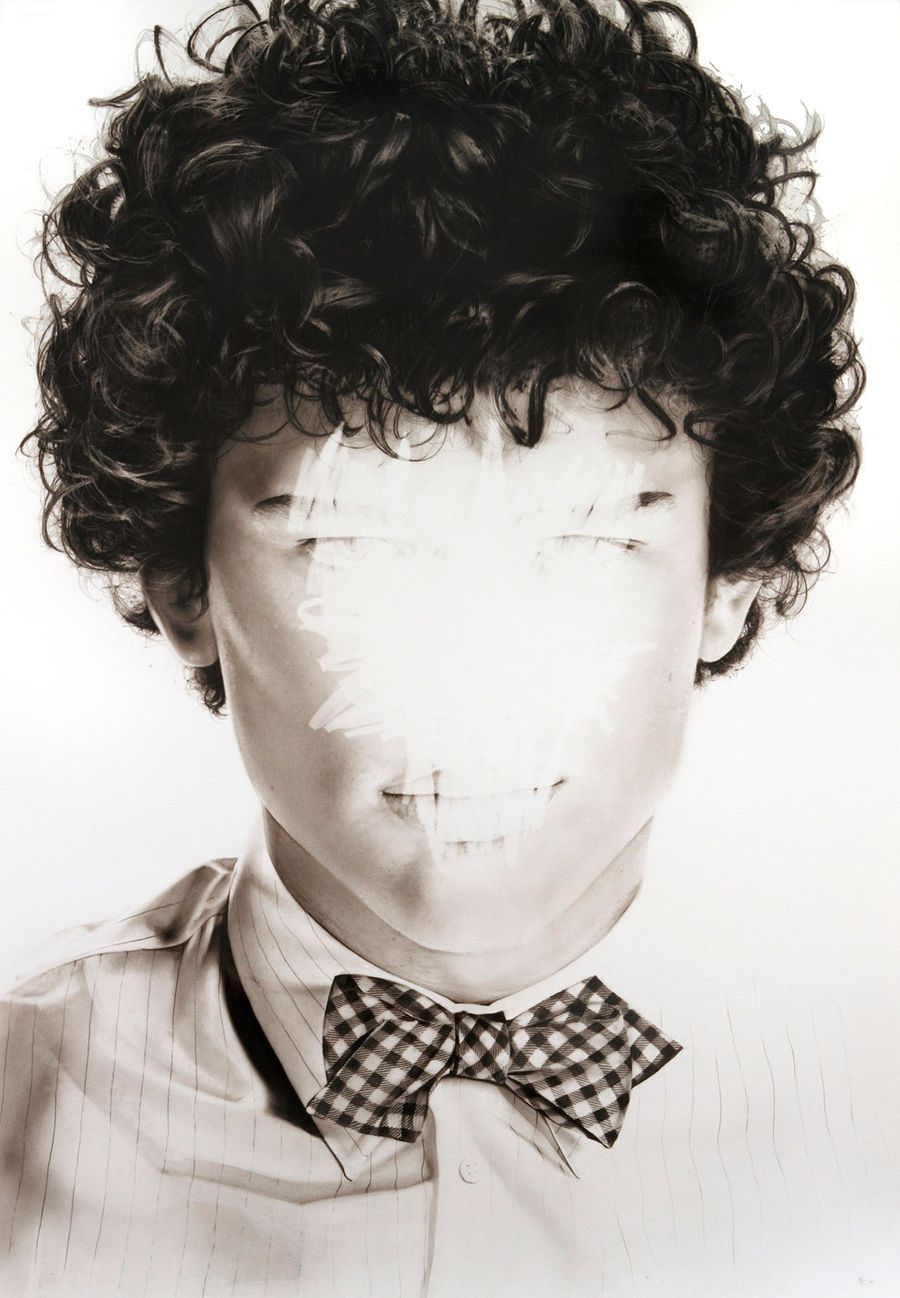
Michael Zavros, Debaser/Marc Jacobs, 2010. Charcoal on paper. 122 x 86cm. Private collection. Courtesy of Smith & Singer Fine Art. © Michael Zavros

Acropolis now (work in progress), 2023. Image courtesy of Michael Zavros. © Michael Zavros

Installation view of ‘Michael Zavros: The Favourite’ at Gallery of Modern Art, Brisbane, 2023. © Michael Zavros. Photography by Joe Ruckli. © QAGOMA

Installation view of ‘Michael Zavros: The Favourite’ at Gallery of Modern Art, Brisbane, 2023. © Michael Zavros. Photography by Joe Ruckli. © QAGOMA

Installation view of ‘Michael Zavros: The Favourite’ at Gallery of Modern Art, Brisbane, 2023. © Michael Zavros. Photography by Joe Ruckli. © QAGOMA

Installation view of ‘Michael Zavros: The Favourite’ at Gallery of Modern Art, Brisbane, 2023. © Michael Zavros. Photography by Katie Bennett. © QAGOMA
The exhibition begins with a series of early paintings including Man in a wool suit (1999) and Ferragamo (2000), exquisite miniatures inspired by luxury advertisements in men’s magazines. “I was the only boy in my family, with four sisters growing up on the Gold Coast, and magazines were something of a portal for me into something or somewhere else”, Zavros explains, “they provided a more sophisticated version of masculinity”.
The concept of masculinity as an advertising and marketing tool is further explored in the Prince/Zavros series which were inspired by American conceptual artist Richard Prince’s ‘Cowboy’ images of the late 1980s, themselves based on the iconic Marlboro Man. 30 years later, Zavros brought Prince’s images back to life, re-introducing them to the public eye in the form of his own, highly detailed paintings filled with nostalgia, emotion and precision.
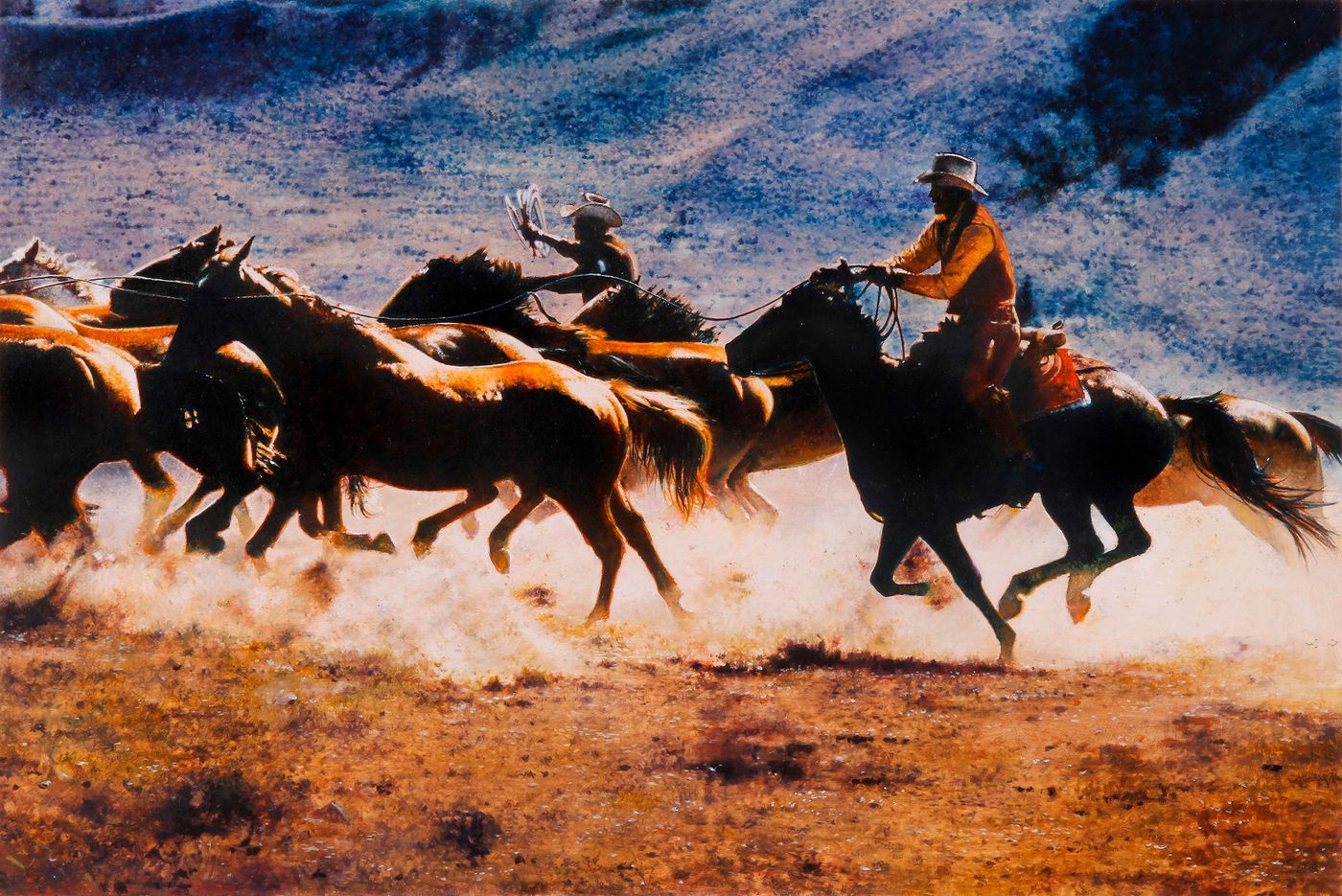
Michael Zavros, Prince/Zavros 16, 2013. Oil on board. 19 x 28cm. Private collection. © Michael Zavros
“I was the only boy in my family, with four sisters growing up on the Gold Coast, and magazines were something of a portal for me into something or somewhere else”, Zavros explains, “they provided a more sophisticated version of masculinity”.
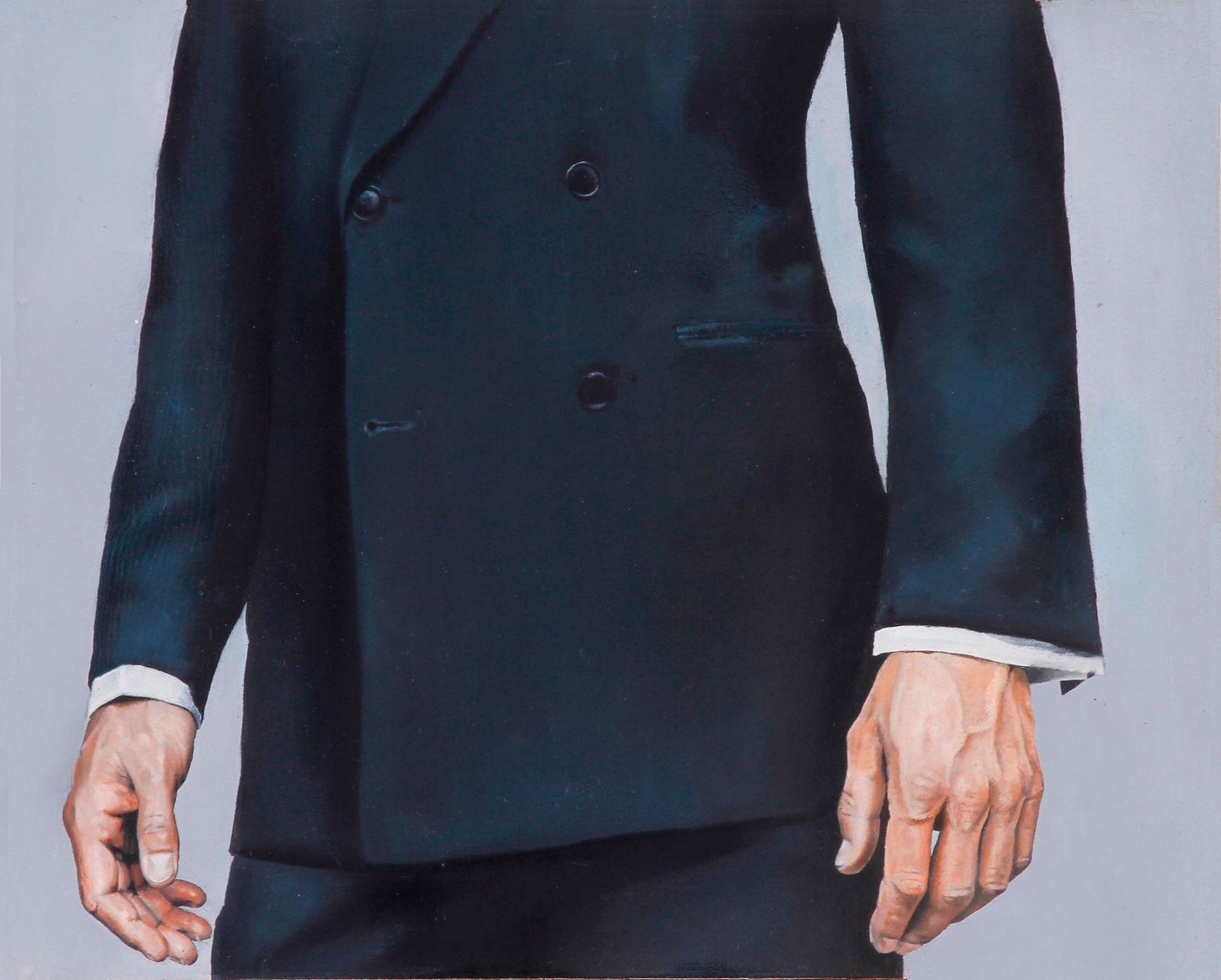
Michael Zavros, Man in a wool suit, 1999. Oil on board. 15.2 x 19cm. Courtesy of the artist. © Michael Zavros

Installation view of ‘Michael Zavros: The Favourite’ at Gallery of Modern Art, Brisbane, 2023. © Michael Zavros. Photography by Joe Ruckli. © QAGOMA

Installation view of ‘Michael Zavros: The Favourite’ at Gallery of Modern Art, Brisbane, 2023. © Michael Zavros. Photography by Joe Ruckli © QAGOMA

Installation view of ‘Michael Zavros: The Favourite’ at Gallery of Modern Art, Brisbane, 2023. © Michael Zavros. Photography by Joe Ruckli. © QAGOMA

Installation view of ‘Michael Zavros: The Favourite’ at Gallery of Modern Art, Brisbane, 2023. © Michael Zavros. Photography by Joe Ruckli. © QAGOMA

Michael Zavros, Ars Longa Vita Brevis, 2009. Oil on canvas. 210 x 167cm. Courtesy of the artist. © Michael Zavros
Portraiture is a major focus within the exhibition with the artist himself a common subject. Echoing the Greek mythological character Narcissus, whose obsession with his own beauty is a cautionary tale of self-absorption, Zavros’ self-portraits are a reflection of the rise of aspirational individualism as much as the self-contained universe of an artist. Inspired by Caravaggio’s ‘Narcissus’, Zavros’ iconic self-portrait Bad Dad (2013) seductively depicts the artist in a swimming pool clinging onto an inflatable as he checks out his own reflection. Whereas Caravaggio’s protagonist stands out amid a dark backdrop, Zavros has framed his subject with vibrant splashes of turquoise to heighten, as he says, the sense of paralysis and stillness.
The spectre of Caravaggio’s ‘Narcissus’ is also evoked in the earlier painting V/12 Narcissus (2009) where Zavros is longingly looking at his reflection on the gleaming hood of his prized black V12 Mercedes Benz. The artist painted the artwork in reminiscence of the times as a child when his father would take him to Mercedes-Benz dealerships— “looking at the cars made my father happy”, the artist explains. For his father, and later for the artist himself, owning a Mercedes was a hallmark of success; a symptom of what Zavros calls his Irish/Greek-Cypriot family's “migrant materialism”. A critique of conspicuous consumerism as a means of social status advancement as well as a jab at our vain, superficial consumerist culture, the immaculately rendered painting also explores the artist’s relationship with his father.
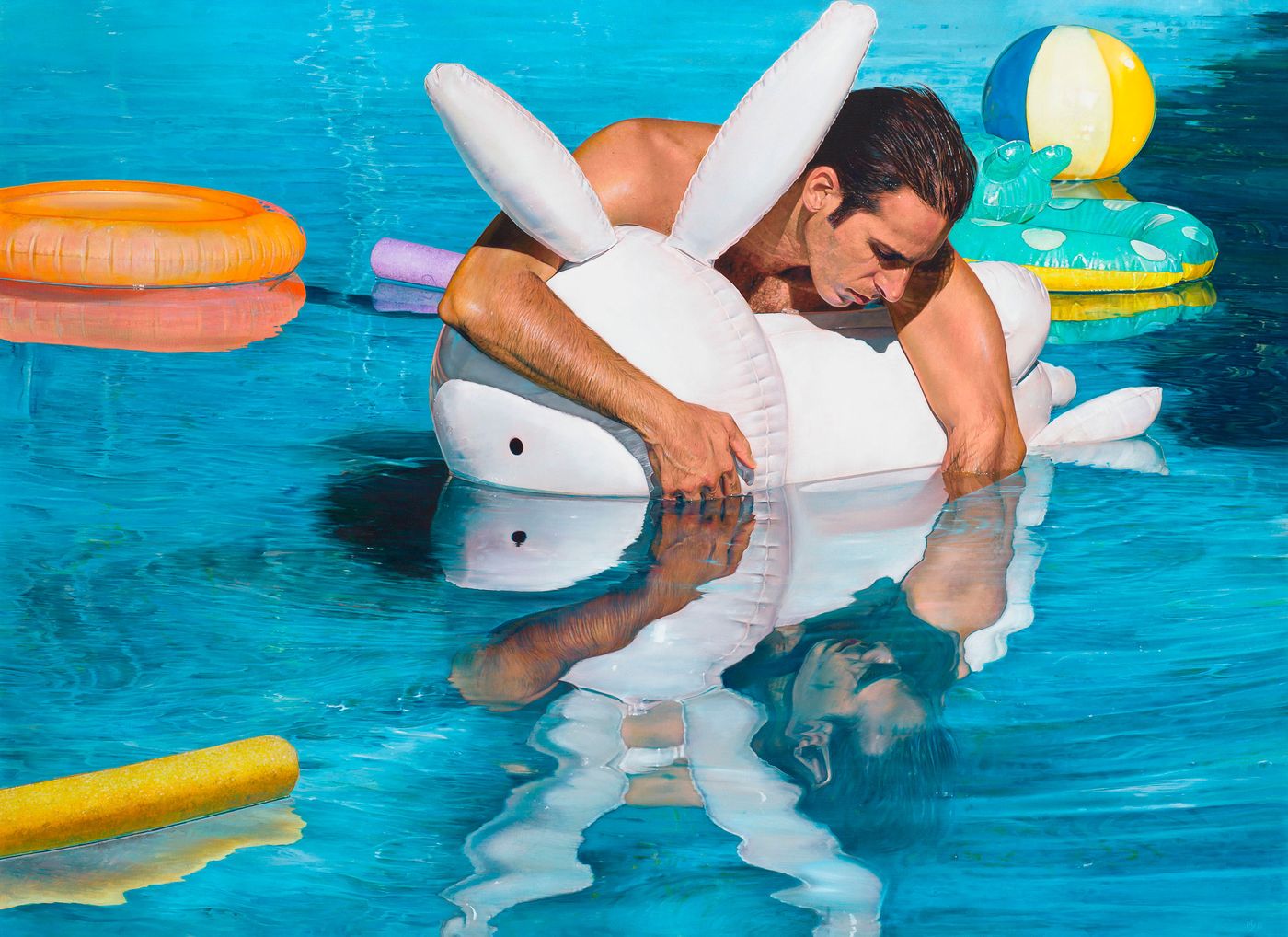
Michael Zavros, Bad dad, 2013. Oil on canvas. 110 x 150cm. Purchased 2016 with funds raised through the Queensland Art Gallery | Gallery of Modern Art Foundation Appeal. Collection of Queensland Art Gallery | Gallery of Modern Art. © Michael Zavros
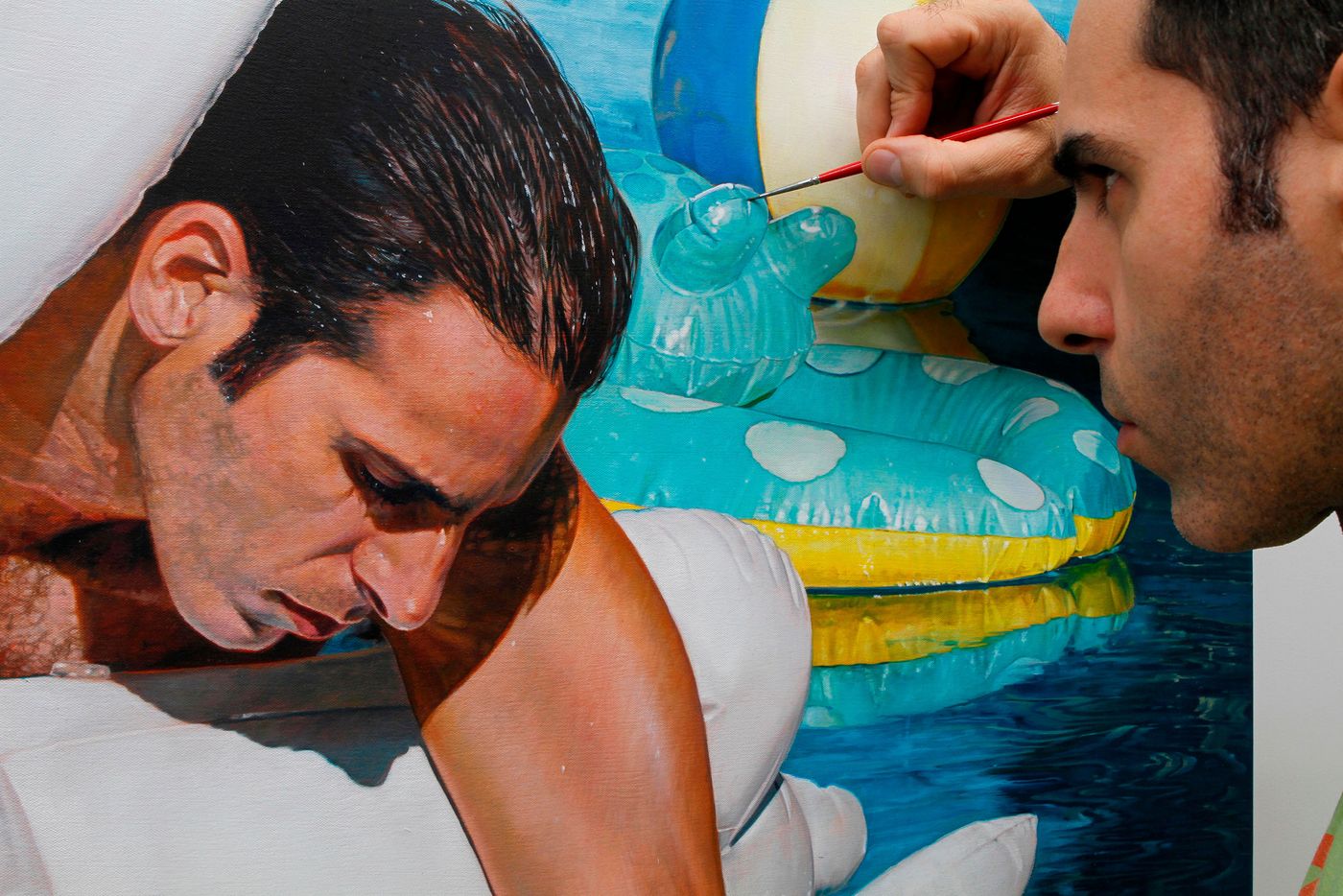
Bad dad (work in progress), 2013. Oil on canvas. 110 x 150cm. Purchased 2016 with funds raised through the Queensland Art Gallery | Gallery of Modern Art Foundation Appeal. Collection of Queensland Art Gallery | Gallery of Modern Art. Image courtesy of Michael Zavros. © Michael Zavros
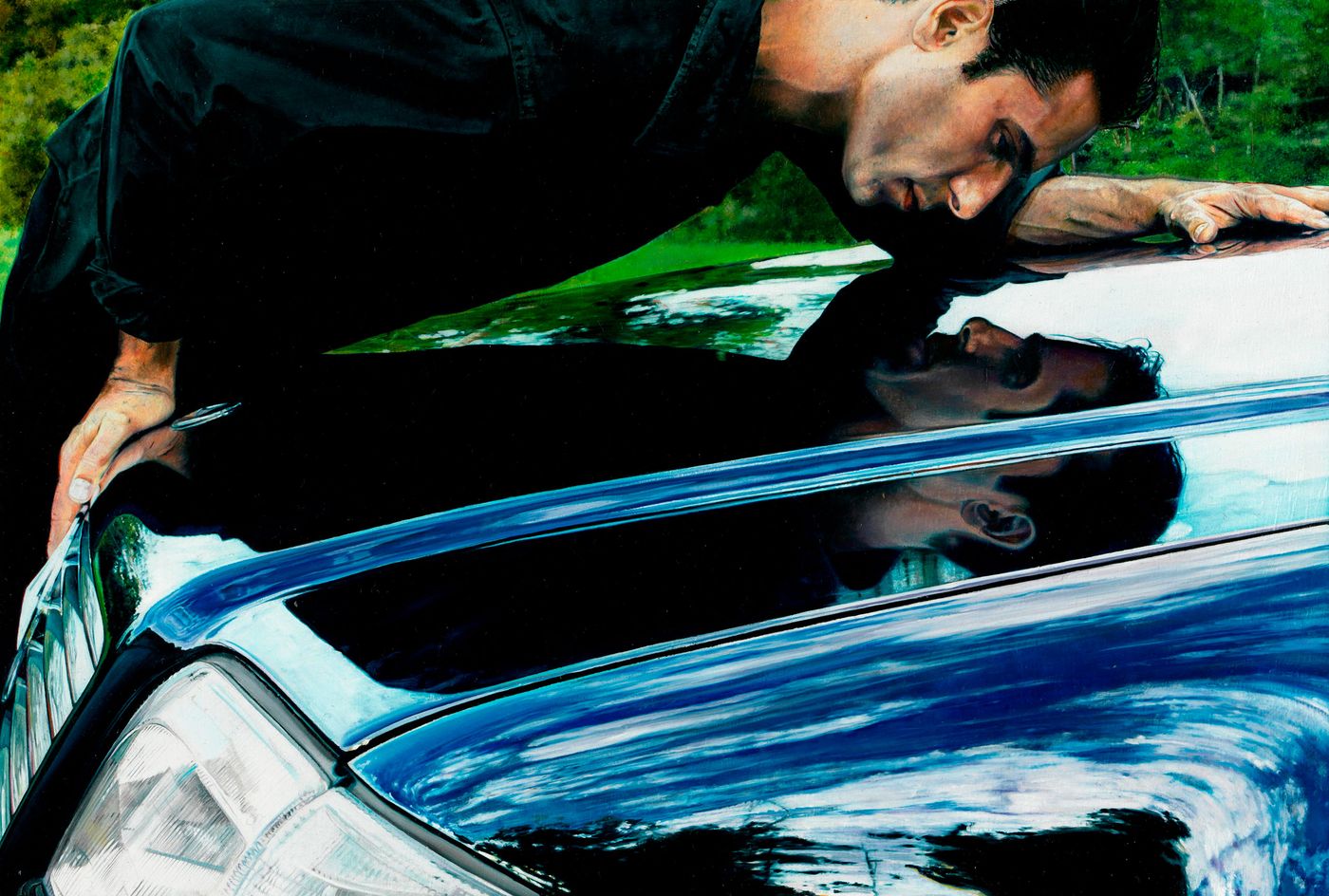
Michael Zavros, V12/Narcissus, 2009. Oil on board. 20 x 29.5cm. Gift of the artist 2013. Donated through the Australian Government's Cultural Gifts Program. Collection of Art Gallery of New South Wales, Sydney. Image courtesy of Michael Zavros. © Michael Zavros
The artist’s Mercedes makes a second appearance in Drowned Mercedes (2023), this time in all its luxurious corporeality. Created for the exhibition, the artist has filled an original classic 1990s Mercedes-Benz SL convertible with water inviting visitors to peer inside and see their own reflection against the exquisitely crafted wood and cream leather interior.

Michael Zavros, Echo 2009. Oil on canvas. 210 x 320cm. Collection of Aaron Giddings. © Michael Zavros
Zavros’ interest in the myth of Narcissus also informs a series of monochromatic paintings of stately European interiors such as Echo (2009) where the most famous room in Versailles, the Hall of Mirrors, is reimagined as “the gym of a narcissistic despot in a post-apocalyptic world”. A masterpiece of hyper-realism measuring over three metres in length, the painting presents the modern pursuit of the perfect body as an echo of aristocratic vanity. On a more personal level, it’s also an echo of Jeff Koons, an artist whom Zavros admires and who just had a big show at Versailles at the time.

Installation view of ‘Michael Zavros: The Favourite’ at Gallery of Modern Art, Brisbane, 2023. © Michael Zavros. Photography by Joe Ruckli. © QAGOMA
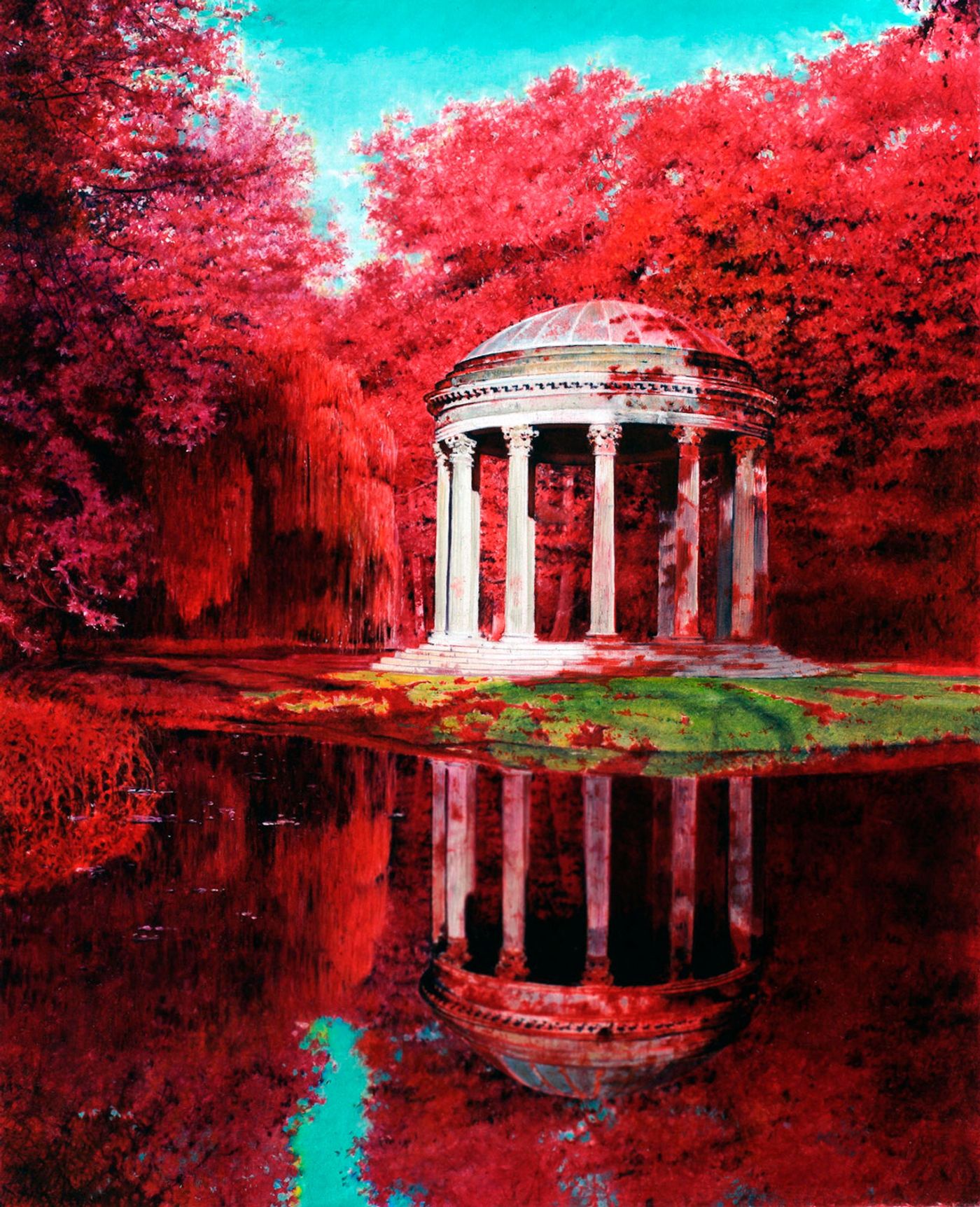
Michael Zavros, Love’s temple, 2006. Oil on canvas. 18.5 x 15cm. Collection of Williamson Elms. © Michael Zavros
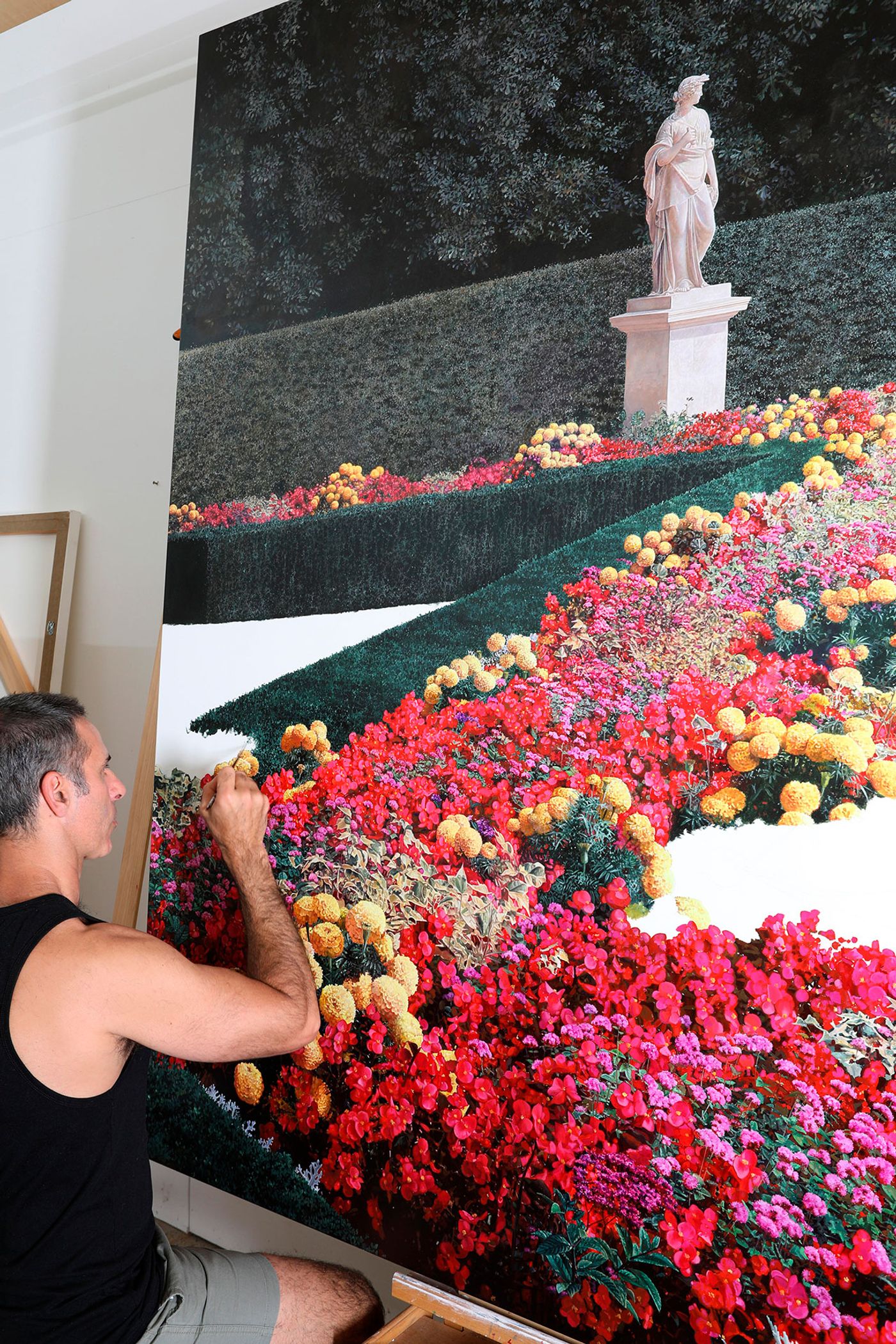
Summer Garden with a Z (work in progress), 2021. Oil on canvas. 200 x 200cm. Balnaves Collection. Image courtesy of Michael Zavros. © Michael Zavros
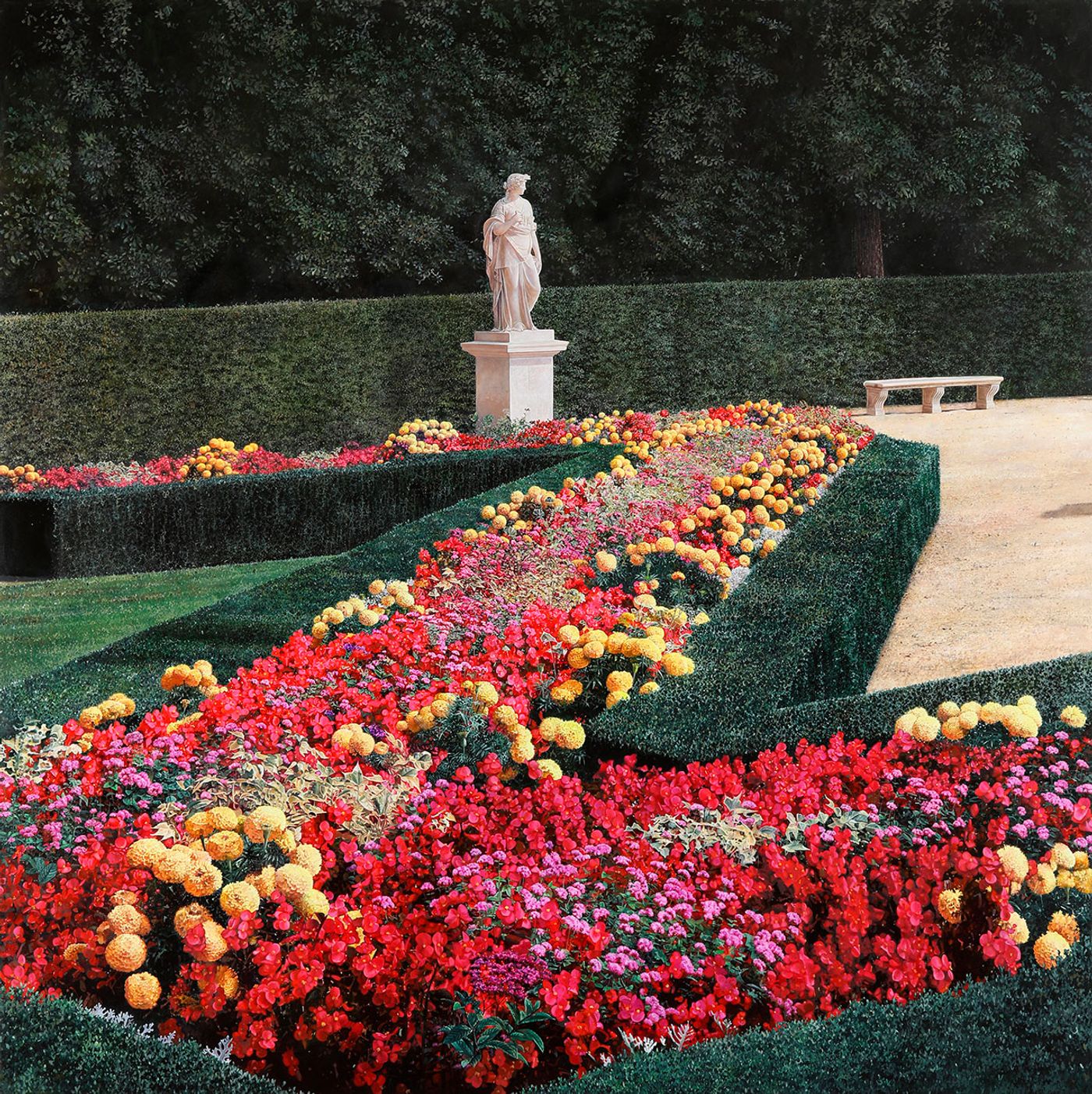
Michael Zavros, Summer Garden with a Z, 2021. Oil on canvas. 200 x 200cm. Balnaves Collection. © Michael Zavros

Michael Zavros in his studio, 2022. Photograph by Chloë Callistemon, QAGOMA. © QAGOMA

Michael Zavros in his studio 2022. Photography by Chloë Callistemon, QAGOMA . © QAGOMA
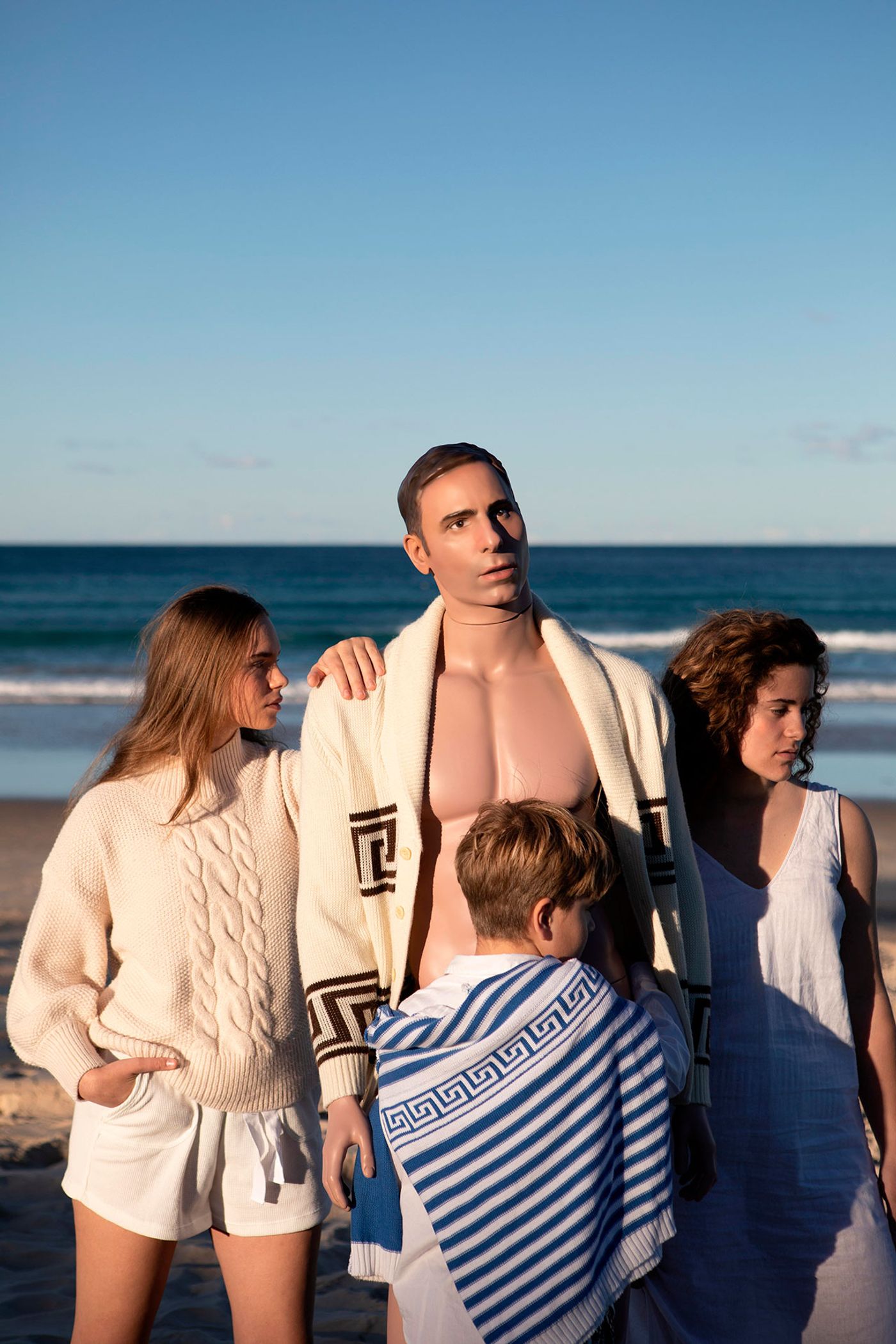
Michael Zavros, Dad likes winter, 2020. Lightjet print on C-type paper; ed. of 3 +2AP. 172.7 x 122cm. Courtesy of the artist. © Michael Zavros
In the photographic Dad Likes Winter (2020), Zavros takes self-portraiture in a different direction with the introduction of ‘Dad’, a bespoke life-size mannequin in the artist’s likeness.Inspired by Barbie doll’s ripped companion Ken as much as by classical Greek statues, ‘Dad’ was conceived as the artist’s aspirational self, a younger, taller and fitter version who would spend more time outside his studio doing his favourite things, including hanging out with his children.
The artist’s depiction of his three children, most notably his daughter Phoebe, can also be considered a type of self-portraiture – in his words, they are his greatest achievement but also hold up a mirror to his failings. In The artist with Phoebe is Eight/Tom Ford (2014), Phoebe stares out of the frame in oversized sunglasses, her childhood innocence subverted by the seductive glamour of the fashion shoot-like composition, while in Mum’s Wedding Dress (2021), a more mature Phoebe wears her mother’s wedding dress in what looks like a very loaded yet innocent gesture. “Of all my children”, Zavros says about Phoebe’s recurring appearance in his work, “she feels the most like me outside of me”.

Installation view of ‘Michael Zavros: The Favourite’ at Gallery of Modern Art, Brisbane, 2023. © Michael Zavros. Photography by Joe Ruckli. © QAGOMA

Installation view of ‘Michael Zavros: The Favourite’ at Gallery of Modern Art, Brisbane, 2023. © Michael Zavros. Photography by Joe Ruckli. © QAGOMA
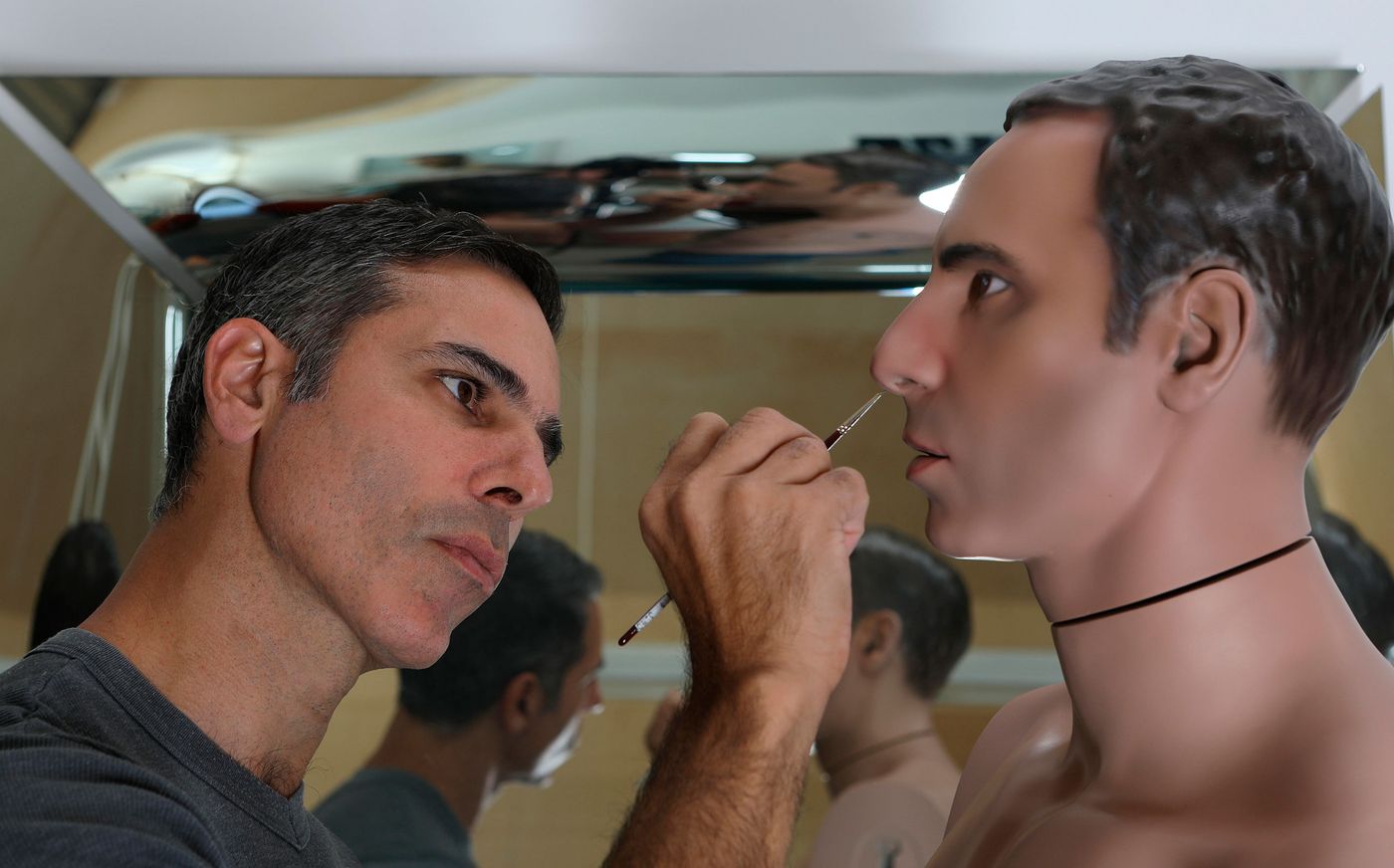
Michael Zavros working on his ‘Dad’ mannequin, 2020. Image courtesy of Michael Zavros. © Michael Zavros
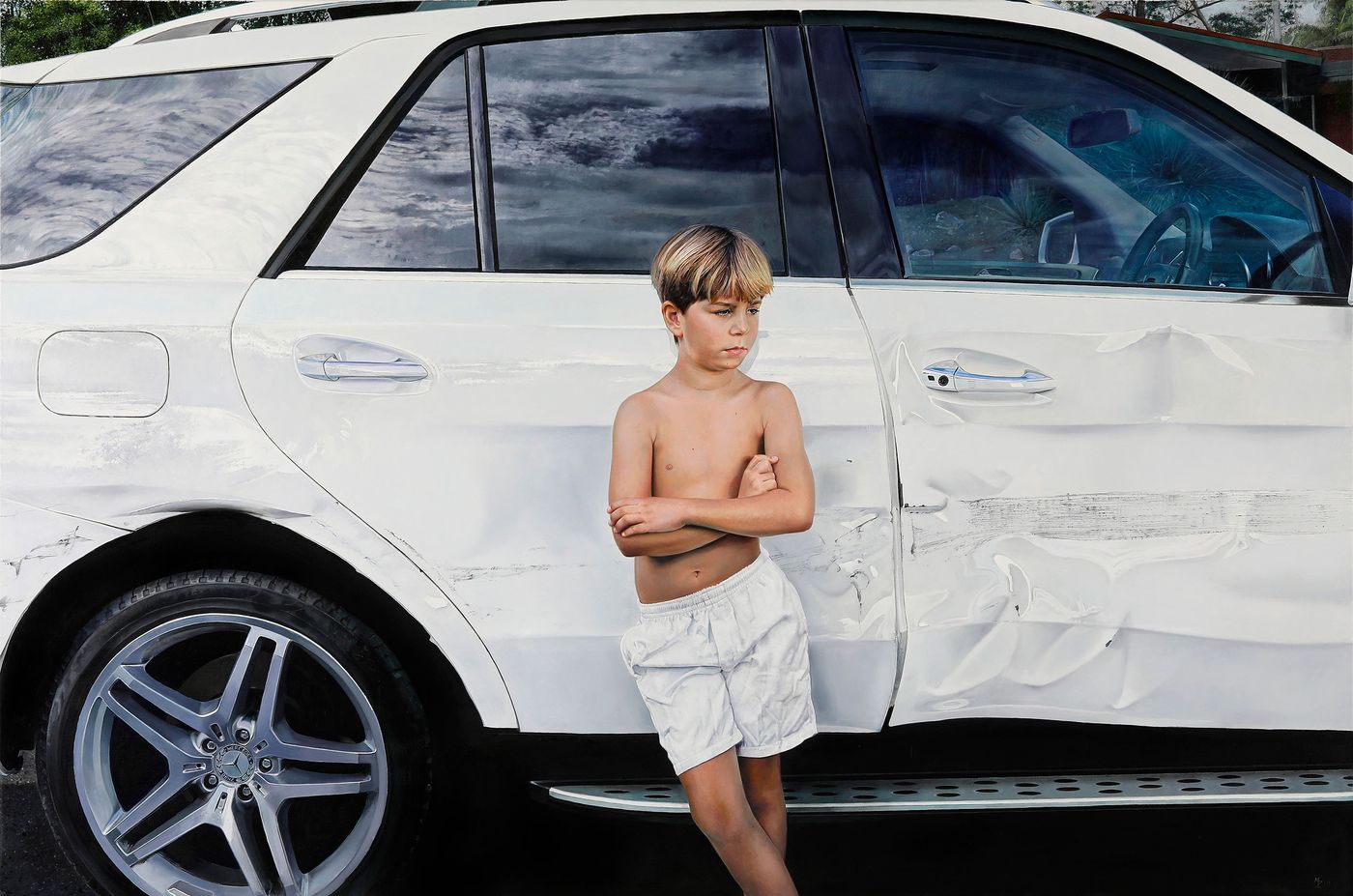
Michael Zavros, White crash, 2019. Oil on canvas. 100 x 150cm. Private collection. © Michael Zavros
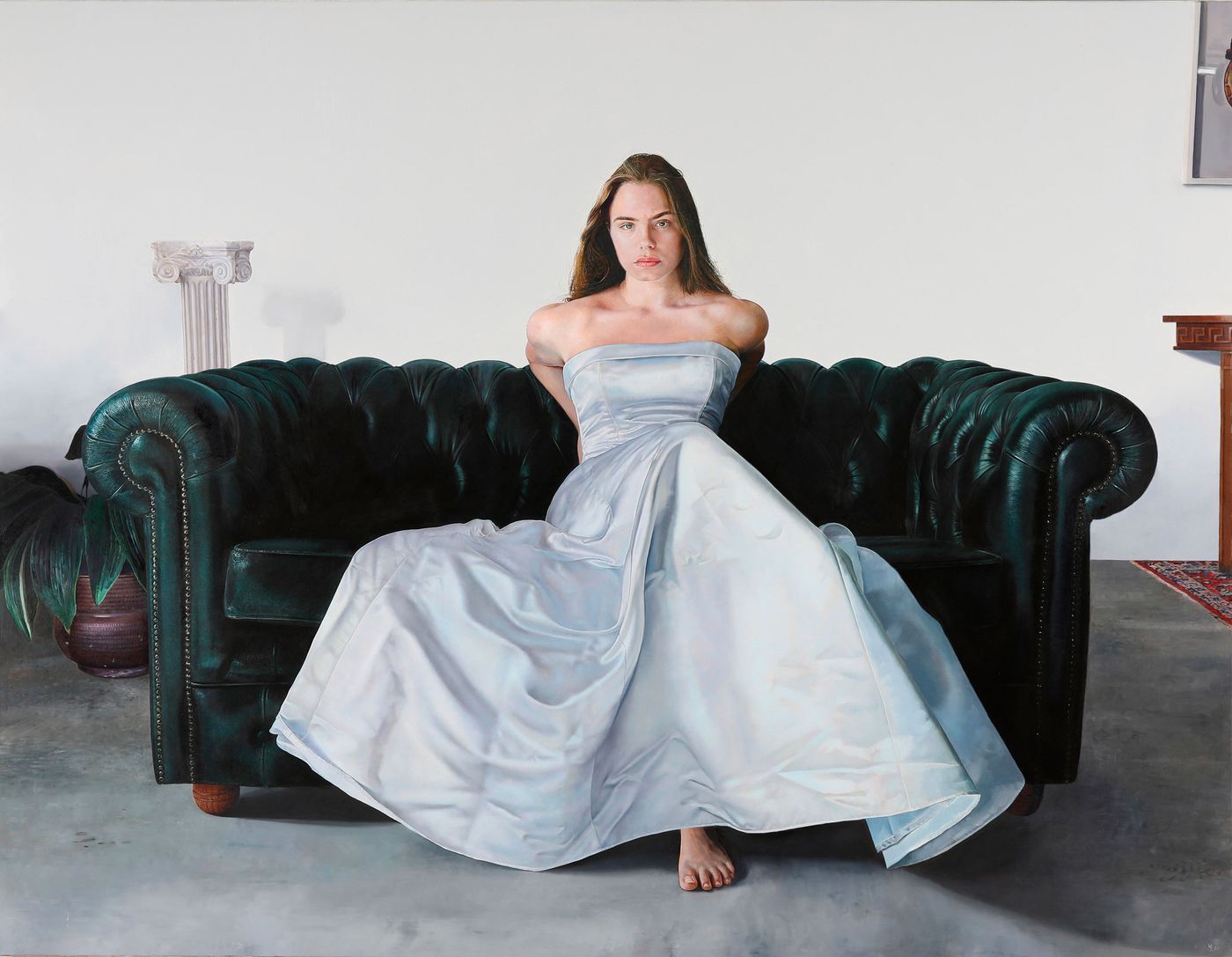
Michael Zavros, Mum’s wedding dress, 2021. Oil on canvas. 160 x 205cm. Courtesy of the artist. © Michael Zavros
Also included in the exhibition are a series of hyperreal still lifes centred on lush flower arrangements that take the form of all kinds of animals, from poodles, peacocks and pandas to the mythological Phoenix, with the help of silk scarves, pearlescent seashells and crystal vases. Described by Zavros as Baroque follies, the paintings are “a meditation on the memento mori tradition – beauty spent”.
The exhibition concludes with Acropolis Now, a monumental, site-specific mural depicting the Parthenon in Athens, “the most famous piece of vandalism and looting” according to Zavros in reference to the Parthenon marbles that reside at the British Museum. Rendered in perspective, the hyper-realistic 7.4-metre-tall mural gives visitors the impression that they are standing on the Acropolis making it a perfect spot for a selfie – there are even some boulders they can sit or stand on. A celebration of the artist’s Greek heritage (Zavros’ father is Greek Cypriot), the work also asks questions about culture – who’s entitled to what, where things belong – as well as continues with the artist’s fascination with ideals of beauty and perfection.

Michael Zavros, The Phoenix, 2015. Oil on canvas. 220 x 200cm. James and Diana Ramsay Fund supported by Philip Bacon AM through the Art Gallery of South Australia Foundation 2016. Collection of Art Gallery of South Australia, Adelaide. Photography by Jon Linkins. © Michael Zavros

Installation view of ‘Michael Zavros: The Favourite’ at Gallery of Modern Art, Brisbane, 2023. © Michael Zavros. Photography by Joe Ruckli. © QAGOMA
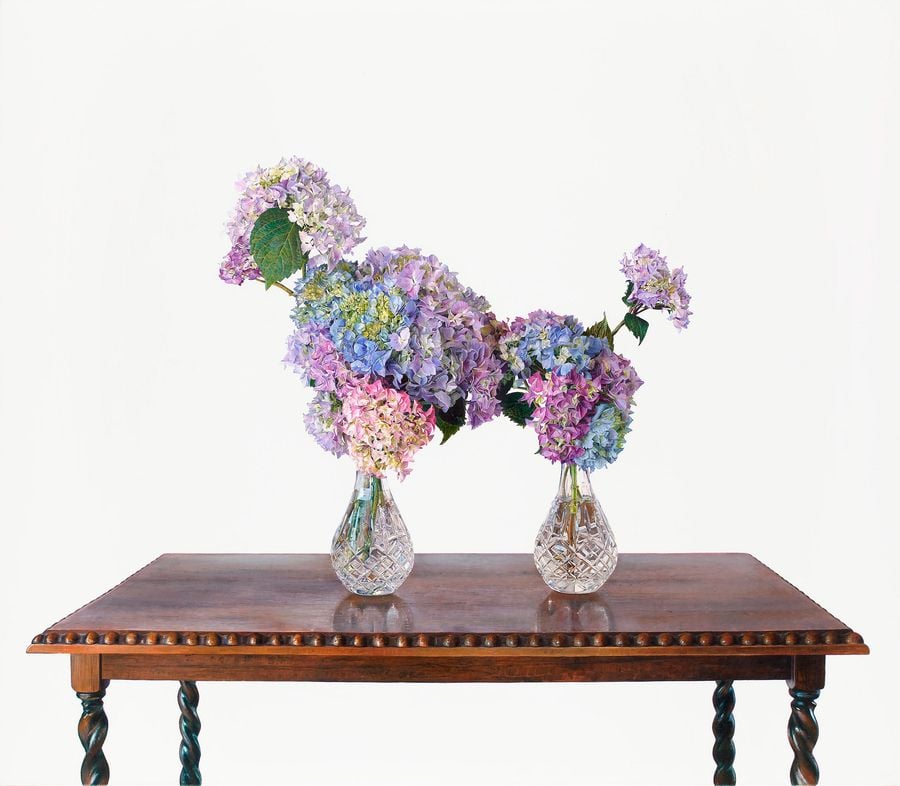
Michael Zavros, The poodle, 2014. Oil on canvas. 135 x 150cm. Private collection. © Michael Zavros
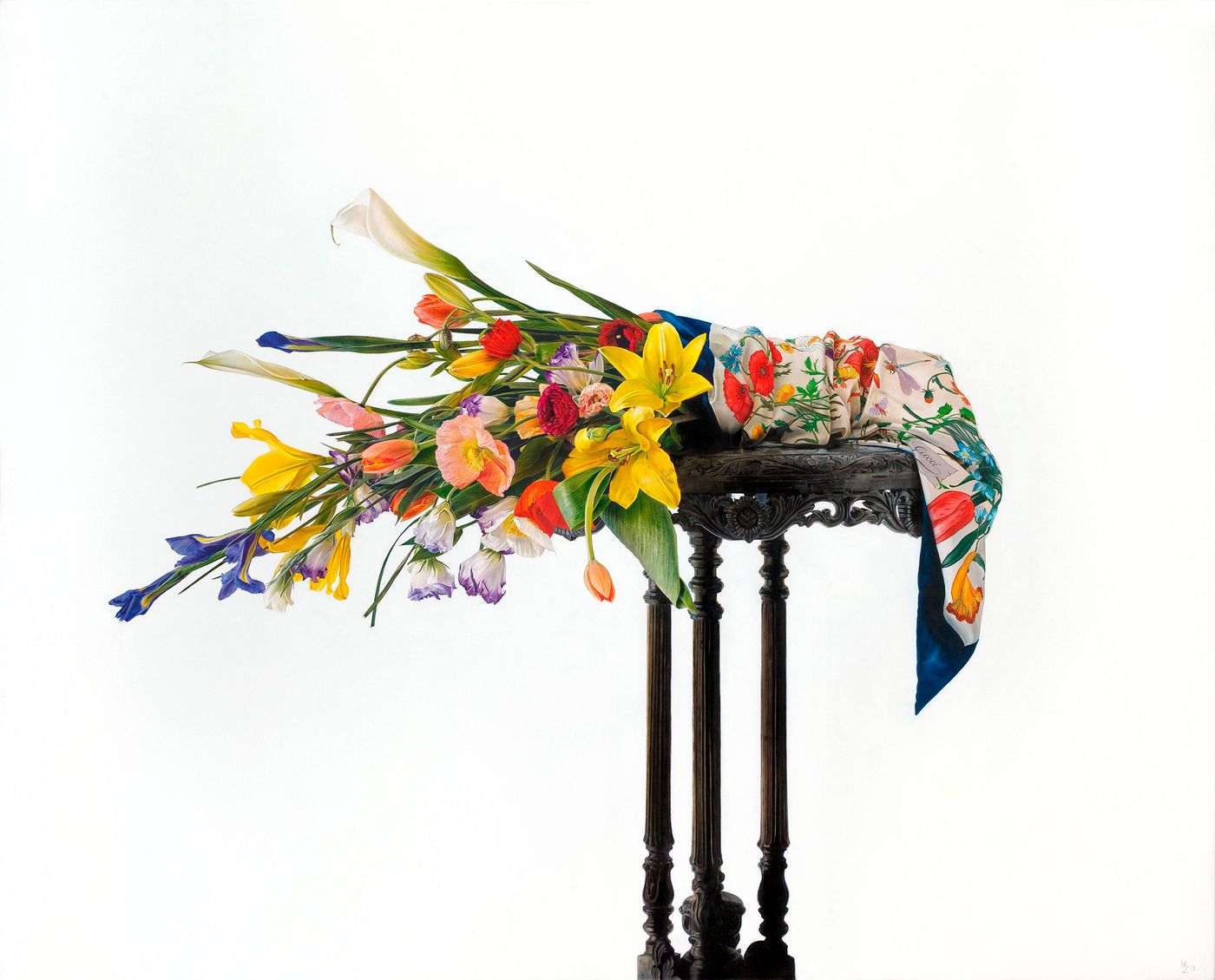
Michael Zavros, The lobster, 2013. Oil on canvas. 120 x 150cm. Private collection. © Michael Zavros
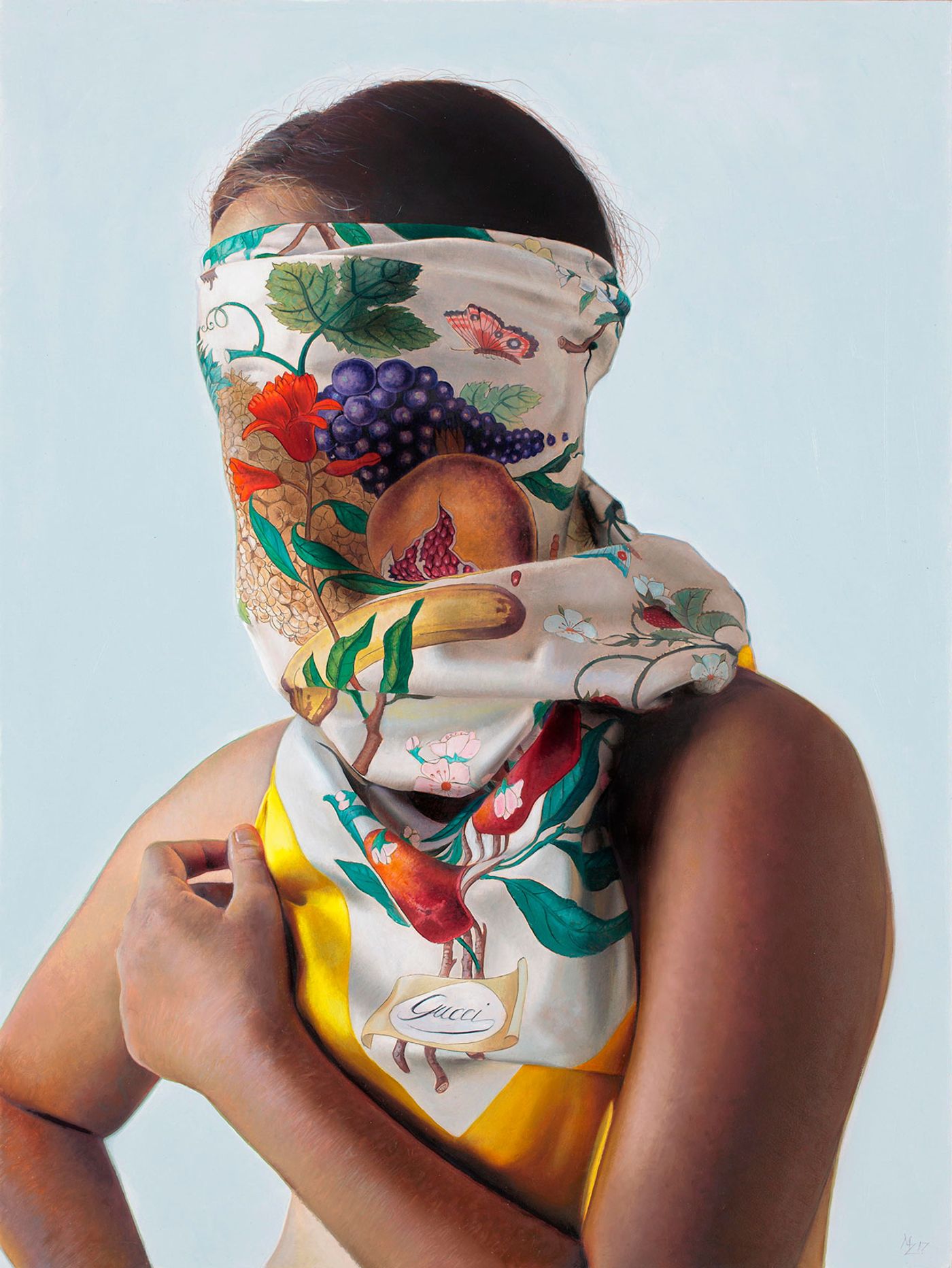
Michael Zavros, Summer fruits, 2017. Oil on board. 40 x 27.5cm. Collection of Allan Lee.© Michael Zavros
